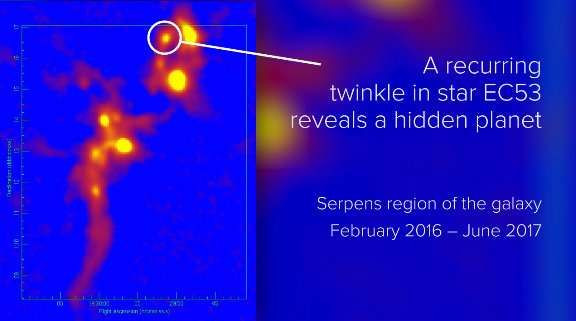Very Young Exoplanet Found Around Star That Twinkles Every 18 Months

A team of international scientists detected erratic variations in the brightness of a forming star. The ‘twinkle’, which occurred every 18 months, was identified as unusual behavior. Scientists claimed this 18-month gap between the twinklings could be due to the presence of a hidden planet.
"This variation in the brightness or twinkle of the star EC53 suggests that something large is disrupting the gravitational pull of the forming star. The fact that it recurs every 18 months suggests that this influence is orbiting around the star — it's quite likely a hidden, forming planet," said Doug Johnstone, Research Officer at the National Research Council of Canada and lead author of the study published in The Astrophysical Journal, in a news release by National Research Council Canada.
The team said the twinkling occurred because a companion planet is orbiting the star EC53.
“The passing gravitational pull disrupts the rate of the gas falling onto the forming star, providing a variation in the observed brightness, or light curve, of the star,” said the release.
Many thanks to the great team who helped find a hidden planet with #JCMT Transient Survey! @PKU1898 @kh_univ @eao_jcmt pic.twitter.com/xcJt9rXvvM
— NRC Canada (@NRC_CNRC) November 1, 2017
Young stars are born in regions of the galaxy where molecular gas is abundant. These regions, known as galactic stellar nurseries, are where the star birth is concentrated.
“When a star is young, gas and dust form a thick cloud that surrounds the star. Some of this material quickly flattens into a disk, in which planets will form. The cloud blocks the star itself from optical view, so astronomers study the star indirectly by using the cloud to learn details about the star growing inside. The star builds up its mass as gravity attracts gas to move from the disk onto the star, a process that also releases significant energy that heats up the surrounding gas cloud,” said the news release.
The telescopic equipment used in these studies are sensitive to sub-millimetre wavelengths. The James Clerk Maxwell Telescope (JCMT) Transient Survey is being used by the team in this study to measure the cloud’s brightness and reveal details about the growth of the star.
The anomaly in EC53's light curve was discovered by Hyunju Yoo, graduate student at Chungnam National University and advisor Jeong-Eun Lee, Professor at Kyung Hee University in South Korea. After running careful analysis of monthly observations of Serpens Main, the stellar nursery under study, the team concluded the “brightness of EC53 has been observed to vary periodically at near-infrared wavelengths for some time, these sub-millimetre observations were essential in validating that the brightness variation was due to heating from gas accreting onto the forming star, rather than variations in the cloudiness of the environment.”
"What caught my eye was a new round of data that showed a sudden brightness that hadn't existed in previous observations," said Lee. "I knew that something unique and interesting must be happening around this forming star. It turned out that it is indeed a very special object, providing a new window into how stars and planets form."
The team will now focus on studying EC53. They will also look for other young stars showing such variations during their growth to learn more about how stars and planets assemble. The team hopes to use other high-tech equipment to study these new stars to gain unique insights into the timescale for the formation of stars and planets, including whether planets form during or after the assembly of the star.
"This discovery marks a turning point; in a sense, it's like sub-millimetre astronomy is moving from taking pictures of our galaxy to taking videos," said Greg Herczeg. “The last 25 years have been devoted to perfecting observing techniques and instruments to allow us to see early star formation. But with recent advances in technology, we can now observe regions changing over time, for a deeper understanding of how stars form. This discovery is just one example of how much more we can now learn."
This discovery was made by James Clerk Maxwell Telescope (JCMT) Transient Survey and the telescope is currently trained at eight galactic stellar nurseries to study variations in the brightness of forming stars. The team behind the study is aiming at understanding how stars and planets are assembled in systems. The survey is led by Doug Johnstone, Research Officer at the National Research Council of Canada and Greg Herczeg, Professor at Peking University (China), and is supported by an international team of astronomers from Canada, China, Korea, Japan, Taiwan and the United Kingdom.
© Copyright IBTimes 2025. All rights reserved.





















